WR Chess Masters R05: Who’s going to stop Aronian?

Levon Aronian’s fifth-round win doesn’t mean it is all over for other participants in the WR Chess Masters, but the 40-year-old is now the clear favourite to win the tournament. After his full point against Anish Giri, Aronian leads the standings with four points from five games, one ahead of Wesley So and Gukesh with three each. With his third win in the tournament, Aronian is back in the world’s top 10 (live ranking). If you’re as good as Anish Giri and Levon Aronian, you don’t need a board to discuss the game. | Photo: Lennart Ootes Anish Giri had surprised Aronian in the opening: Berlin Defense instead of the Open Ruy Lopez Aronian had expected. Perhaps it was his four drawn games in a row that tempted Giri to push things harder on move 21 instead of simplifying into a hardly dangerous endgame? As a result, the world number five came under pressure and eventually even had to allow Aronian to double two rooks on his seventh rank. That could not end well. Vincent Keymer was the second winner of the day. After 17 winless super-tournament games in Wijk aan Zee and Düsseldorf, he was granted a full point in the 18th. Keymer is no longer at the bottom of the table, at least not alone. He is now part of a quintet with two points from five games. After 0.5 points scored in the last three games, Nodirbek Abdusattorov is part of that quintet as well. In the game between the two best 18-year-olds in the world, Abdusattorov played his part in making it a battle worth watching. Whether his pawn sacrifice in the opening was improvisation or preparation is unclear. “I certainly didn’t believe him,” Keymer recounted after the game. The critical move of the game: Abdusattorov could have played 23…Bxb4, probably nothing would have gone wrong for him. But he didn’t resist the temptation to play 23…Bb6?!! and invite Vincent Keymer to 24.b5, which only seems to win the c6-bishop. Abdusattorov had planned 24…Re6! (the only move that doesn’t lose) with a huge Black’s attack. Despite Keymer’s disbelief, Abdusattorov was to put up strong play against the white kingside. But then he succumbed to the temptation of a pseudo piece sacrifice for further attack instead of moving the game into calm waters that might even be slightly advantageous for Black. When Abdusattorov finally slammed a rook into the white castling position, Keymer thought it was “almost a miracle that I’m not mated, it looks so dangerous.” All the black pieces were perfectly placed, he said, except that “he has too few of them, unfortunately.” The Keymer stare, now a trademark of the world’s second-best 18-year-old. | Photo: Lennart Ootes For Praggnanandhaa, there was a very good reason to end the game early against Jan-Krzysztof Duda. His sister Vaishali was playing for her team “Indian Yogis” against the “Canada Chessbrahs” in the Pro Chess League on Tuesday afternoon. And in their ranks was a certain Magnus Carlsen. Who wouldn’t want to watch his sister play a live match against the World Champion? Unfortunately, the game seemed to be heading for a heavy-piece endgame, which could have been an opportunity for the Indian to celebrate his love of grinding out small advantages. But it didn’t come to that. A hasty advance by Pragg on the kingside gave Duda the counterplay he needed to keep the game in balance and force a repetition before move 40. Pragg now has two reasons to be dissatisfied with his fifth round. Against Duda, he could have pressed longer and possibly got more out of it. And Vaishali vs. Carlsen, he still had to watch in the replay. The door to tournament victory is not yet closed for Jan-Krzysztof Duda, but with 2 points from 5 games, he will have to finish with a huge push if he wants to be on top in the end. | Photo: Lennart Ootes Aspiring World Championship finalist Ian Nepomniachtchi failed to gain momentum for everything else on Rest Monday. Nepo’s draw streak continued, and he even has to be satisfied with that. With the black pieces, his opponent Gukesh managed to outplay the world number two in a symmetrical, balanced position. Nepomniachtchi can at least take away from this encounter that he held it. When he found himself in an extremely critical endgame down a pawn, Nepomniachtchi rallied to a precise defensive performance and saved at least half a point. Got away with half a point: Ian Nepomniachtchi is not yet in World Championship form. | Photo: Lennart Ootes There wasn’t much action between Andrey Esipenko and Wesley So in the fifth round. Esipenko didn’t think he got anything out of it with White, and So thought a draw with Black was a decent result. The two repeated moves, and after 22 moves, the game was drawn. Text: Official website Photo: Lennart Ootes Offical website: wr-chess.com/
FIDE resolution on the Russian Federation joining the ACF

The FIDE Council reviewed yesterday, February 21, the report prepared by the Constitutional Commission on the request made by the Chess Federation of Russia (CFR) to join the Asian Chess Federation (ACF). The Asian Chess Federation is expected to decide on this request at its General Assembly, which will take place in Abu Dhabi on February 28. Its acceptance would automatically imply that the Chess Federation of Russia withdraws its membership to the European Chess Union, since a federation cannot belong to two continents at the same time. In view of this, and after examining all legal considerations presented to them by the Constitutional Commission, the FIDE Council has made two main decisions: 1) To rename Zone 1.6 (Russia) as Zone 3.8, as part of Asia, effective May 1, 2023, given that the Asian Chess Federation confirms it accepts the Chess Federation of Russia as a member in their General Assembly. 2) To adopt a series of additional measures to protect those players who decide to leave the Russian Chess Federation at this point and join any European chess federation. Players previously belonging to the CFR will be allowed to represent their new federation with immediate effect, from the next day of submitting their application, without any restrictions. All transfer fees, to FIDE or CFR, are waived. You can read below the full resolution: FIDE Council Resolution Whereas: 1) Chess Federation of Russia (CFR) has informed FIDE about their request to be accepted as a member of the Asian Chess Federation (ACF); 2) FIDE Constitutional Commission (CC) has reviewed the matter from the legal perspective and recommends the FIDE Council revise FIDE zones before such transfer of RCF to ACF; 3) CC has highlighted the need to provide the minimum remedy and fairness to players who have chosen to remain in European Chess Union (ECU), FIDE Council decides: 1. To approve that Zone 1.6. (Russia) from May 1, 2023, is considered to belong to the Asian zone, and will be renamed as Zone 3.8. 2. To approve that: 2.1. All the transfer fees to FIDE and compensation fees to the CFR are waived for any player who has previously been registered with the RCF and who, from March 1, 2022, until August 31, 2023, has applied or will apply for the membership of any of the ECU’s federation. 2.2. All these players (further – Players) have the right to represent the new federation in all official individual events of FIDE from the next day of submitting their application without any restrictions, provided that all other conditions for the transfer have been met besides paying the fees. Such applications should be checked and confirmed or rejected (only if the application contradicts art. 2.6. of the current Transfer rules) by FIDE 15 days after their submission. 2.3. The conditions mentioned in Articles 2.1 and 2.2 of this resolution also apply to Russian players who have transferred to the special FIDE status. 2.4 In the event that the Players decide to leave the national federation to which they transferred under the above procedure, such a federation is not entitled to receive any compensation fee. Also, these Players can transfer to CFR later with no fees to be paid to their previous national federation or FIDE. 2.5. The right of such Players to participate in European team competitions is determined by the decision of the ECU, without any additional restrictions from FIDE. The decision about the rights of such Players to represent the new federation in FIDE team competitions should be approved by the FIDE Council no later than by May 1, 2023. 2.6. To avoid any doubt, official FIDE competitions are FIDE world championships and events providing direct qualification spots to FIDE world championships, FIDE Candidates tournaments and the FIDE World Cups. 3. Both above-mentioned decisions come into force, given the Asian Chess Federation (ACF) accepts the Chess Federation of Russia (CFR) as a member of the ACF as of May 1, 2023. 4. If the date of ACF accepting CFR as its member differs, the above decisions apply from the same date, respectively. 5. To create a FIDE working group for further revision of the structure of FIDE zones according to the opinion of the Constitutional Commission.
Oleiny Linares wins 2023 Cuban Women’s Championship

Oleiny Linares emerged as the winner of the 57th Cuban Women’s Championship. WGM from Santiago took her third national title in fierce competition with top-rated IM Lisandra Ordaz. The 12-player round-robin with classical time control took place in José Raúl Capablanca Academy in Camagüey from February 09-20. The event turned into an exciting race between Lisandra Ordaz (pictured below, left), WGM Yerisbel Miranda and Oleiny Linares (pictured below, right). Ordaz was in the lead for most of the event, but Linares caught up with her coming into the final round, while Miranda trailed by 1.5 points. In a dramatic final round, Ordaz suffered a defeat with the white pieces at the hands of Yaniela Forgas, whereas Linares drew her game with Yoana Gonzalez and clinched the title by scoring 8.5/11. The champion became the only paricipant to complete the tournament unbeaten. Lisandra Ordaz had to settle for silver. Yerisbel Miranda finished on 7/11 and took bronze. Final standings: 1 WGM Linares Napoles, Oleiny 2179 8½ 2 IM Ordaz Valdes, Lisandra 2312 8 3 WGM Miranda Llanes, Yerisbel 2269 7 4 WGM Forgas Moreno, Yaniela 2304 6½ 5 WGM Arribas Robaina, Maritza 2225 6 6 WFM Muniz Guevara, Amanda 2057 5½ 7 FM Hernandez Machado, Patricia 2143 5½ 8 WIM Hernandez Gil, Ineymig 2158 4½ 9 WIM Gonzalez Ochoa, Yoana 2104 4½ 10 WIM Obregon Garcia, Roxangel 2158 4 11 WFM Gutierrez Espinosa, Karen 2110 3½ 12 WFM Cabrera Ladron, Mayra 1923 2½ Photo: Federación Cubana de Ajedrez
Chess events to celebrate the International Women’s Day set in Tirana, Albania
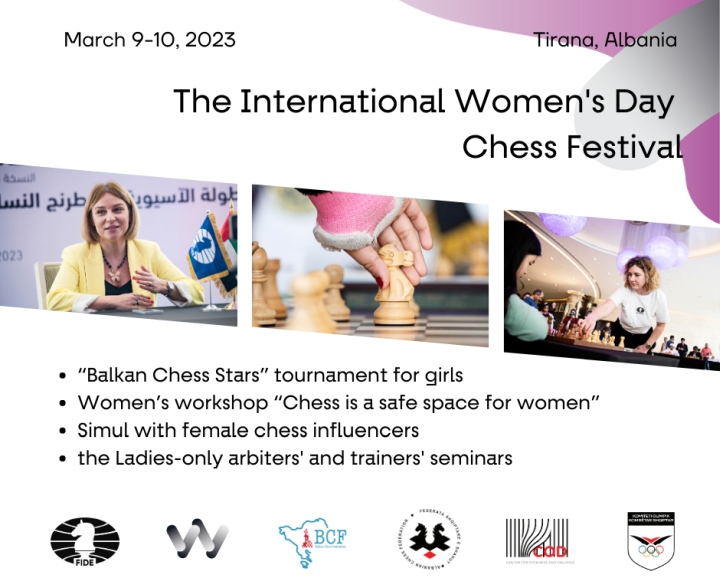
International Chess Federation, Balkan Chess Federation and Albanian Chess Federation, in collaboration with Albanian Center for Openness and Dialogue, are pleased to announce the International Women’s Day Chess festival, a series of chess events to celebrate the International Women’s Day and reinforce a commitment to women’s equality. The large-scale celebration will be held from March 9-19, 2023. It will start with the “Balkan Chess Star” tournament, the women’s workshop “Chess is a safe space for women”, organized with a contribution from ECU Women Commission, and a simul with female chess influencers, scheduled for March 9-10 in Tirana, Albania. The events will take place at COD – Center of Openness and Dialogue, located within the Prime Minister and Council of Ministers Edifice. The “Balkan Chess Star” blitz tournament is played by 16 girls born in 2007 and younger, representing all Balkan countries, who will first compete in 2 round-robin qualification events on March 9. The Final between the winners of each event is scheduled for March 10. Workshop and simul by chess influencers will feature Dana Reizniece-Ozola, WGM, FIDE Deputy Chair of Management Board; Antoaneta Stefanova, GM, former Women’s World Champion; Anastasia Sorokina, WIM, Chair of FIDE Commission for Women in Chess, international arbiter; Agnieszka Milewska, Director of the Women’s Chess in England; Carol B Meyer, Executive director of the US Chess Federation and Majlinda Pilinci, General Secretary of Albanian Chess federation, member of FIDE PDC Commission, international organizer. Programme of the festival: March 9 14:30 – 15:00 Opening ceremony with officials (FIDE, Albanian Ministry of Education and Sports, NOC Albania, Balkan Chess Federation, Albanian Chess Federation, special guests). 15:00 – 17:30 The “Balkan Chess Star” tournament. Qualification stage 17:30 – 20:00 Workshop “Chess is a safe space for women” Simul with female influencers March 10 10:30 – 13:00 The “Balkan Chess Star” tournament. Final stage 2-hour session with GM 14:00 The Closing Ceremony The events will be followed by the Ladies-only arbiters seminar held by IA Panagiotis Nikolopoulos (GRE), IA Mihail Prevenios (GRE), and IA Tshepiso Lopang (BOT) from March 10-12. The Seminar will award norms and titles of FIDE Arbiter and is open for national arbiters nominated by their federations. The Online FIDE Trainers’ Seminar for female trainers organized by the FIDE TRG Commission in partnership with the FIDE WOM Commission, scheduled for March 17-19, will finalize the celebration of International Women’s Day. Contact details: Majlinda Pilinci: pilincimajlinda@gmail.com Anastasia Sorokina: a.sorokina@fide.com
WR Chess Masters R4: Burned bridges and kicked down doors
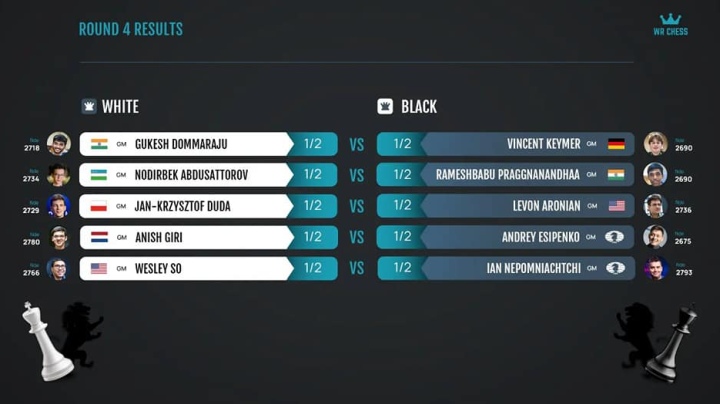
It smelled like a draw shortly after move 30, when a symmetrical rook ending had developed between Nodirbek Abdusattorov and Praggnanandhaa. More in jest, almost giggling, Yasser Seirawan and Anastasia Karlovych listed the academic advantages of the white position on the livestream: a little more space, a slightly more active king, a slightly more active rook. They didn’t say it, but let it slip that they expected a peace deal at any moment now. In the livestream, Anish Giri lectures on the difference between human and machine advantage. One grandmaster on the sofa, Giri second Jan Gustafsson, is listening attentively. The other, tournament director Sebastian Siebrecht, is already busy planning for the Carnival Monday. | Photo: Lennart Ootes The two experts were wrong. Until move 58, Abdusattorov tried to turn his mini-advantage into something tangible. Only when each of them was left with a single rook did the Uzbek and the Indian make peace. Their flawless game may serve as proof that it’s not for lack of fighting spirit that draws are recorded after the dust has cleared. Five such draws were recorded in the fourth round. When observers had long since put the game to bed, Praggnanandhaa had to fend off continued attempts by Nodirbek Abdusattorov. | Photo: Lennart Ootes Jan-Krzysztof Duda and Levon Aronian had such a game on the board, not as long, but with more dust. Just how much they both wanted it was soon evident from the fact that they both ignored the safety of their king. Instead of keeping their own lines closed, they blithely charged the lines opposite of them, a game along the motto of “burn bridges behind me, kick down doors in front of me”. However, in chess, this kind of action can lead to forced sequences. The foreseeable wild skirmish only rudimentarily took place. Then Duda spotted such a forced move sequence, one that secured him a perpetual check and half a point. And, more importantly, no alternative presented itself. Since anything else would have been punished by mate, Duda took the perpetual check and the half point. Anish Giri spared the audience chess tantrums like the one in the paragraph before this one when he dissected his game against Andrey Esipenko in the stream following the draw. Giri instead had insights to offer. In chess, he said, there are two kinds of advantage, the human-organic one and the one that comes from better knowledge of engine variations. The latter, Giri lectured, was much more difficult to convert. Indeed: If a man has gained an advantage on the basis of his plans and manoeuvres, then the basis for expanding this advantage is already given. If a man sits in front of a position in which he only knows that the engine evaluates it with “+0.5”, then his planning and manoeuvring start at zero. Giri, who may be the most knowledgeable player in the world in terms of chess theory, unfortunately, achieves engine advantages much more often than organic ones. And he fails to exploit them – as he did on Sunday against Andrey Esipenko. Vincent Keymer would be happy to find any advantage at all, regardless of its nature. With 0.5 points from 3 games, a target was looming on his back, and now he was facing his third black game, against Gukesh this time. Still, it was time for Keymer to strike, Seirawan felt – he might do a comeback as Praggnanadhaa had done the day before, securing a win after two losses. The local hero didn’t have a choice anyway. Gukesh, possibly assuming that he was facing a battered opponent, immediately instigated a brawl. Spread across the board, Keymer had to tame an intermediate move here, a mate there, a skewer here, and a running passed pawn there. The German number one had no choice but to let up his guard and parry what came. Keymer didn’t show any weakness but also didn’t find a gap through which to counter – draw. Most chess players are happy to have the bishop pair, and in the face of an extra pawn, not only the self-confessed “pawn-grabber” Yasser Seirawan clicks his tongue. Wesley So had both a bishop pair and an extra pawn against Ian Nepomniachtchi. Ian Nepomniachtchi conceded a pawn and the bishop pair to Wesley So. That had nothing to do with the joy of giving. | Photo: Lennart Ootes However, Nepomniachtchi had voluntarily given him both, first the pawn, and then the bishop. He was by no means motivated by the joy of giving but by the assessment that So would not be able to make anything out of the two advantages in the given constellation. The prospective world championship finalist was to be proved right. After the first time control, this game also ended in a draw. Interviews and game analysis in the feed Text: Official website Photo: Lennart Ootes Offical website: wr-chess.com/
Svetozar Gligoric Award for fair play
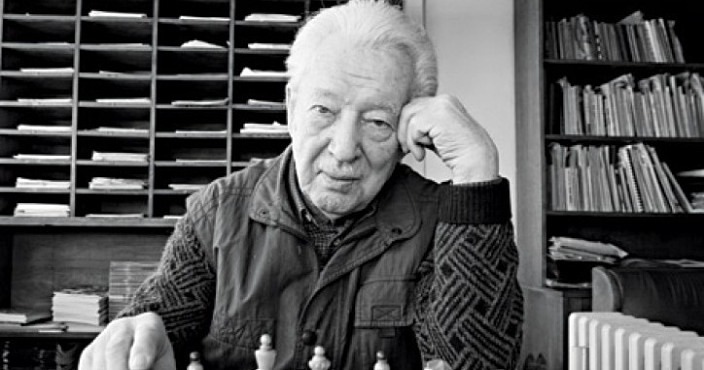
Last year, at the first quarter Presidential Board meeting, FIDE decided to establish a fair play award named after Svetozar Gligoric. In the 1950s and 1960s, Svetozar Gligoric was one of the top players in the world and one of the World’s most prominent, owing to his particularly engaging personality. At the chessboard, Gligoric was an uncompromising fighter and at the same time a symbol of gentlemanhood and correctness. His impeccable reputation has been a deserved result of his success in chess games and fair-play manners. Gligoric’s trademark was high respect to his chess opponents: his main principle was – It’s chess pieces, not a man I play against! It is no coincidence that the book of Gligoric’s selected games is called “I play against pieces!”. The spirit of the “Fair Play Svetozar Gligoric Trophy” is to give recognition to an individual who, during the previous year, had displayed exemplary behavior that promotes the spirit of fair play and sportsmanship in chess. We would like to stress that this is an award for the nominee’s accomplishments during the previous year, and NOT a recognition of a lifelong career. Unfortunately, most of the applications we have received didn’t meet this particular criterion. In view of this, the Commission in charge of this award, chaired by FIDE Vice-Presidential Mr. Mahir Mammedov (AZE), has decided to extend the deadline for submissions. The new deadline will be July 15, 2020. The applications must be in connection with accomplishments during the period January 1st, 2019, to July 15, 2020. The regulations can be found below. Along with Mr. Mahir Mammedov, the other two members of the Svetozar Gligoric Award Commission are the Grandmasters Mrs. Judit Polgar (FIDE Honorary Vice-President) and Mr. Eugenio Torre. REGULATIONS Svetozar Gligoric Award is a recognition of sportsmen who exercise the fundamental values of Fair Play both during and beyond the game. It’s a way of thinking rather than a mere behavior and includes the concept of: FairnessTo enjoy the victory is not enough. Triumph must include fairness and honestyRespect Written rules are mandatory. Unwritten rules of respect to all are obligatoryFriendshipRivalry in sport does not exclude friendshipTeam SpiritA genuine consideration for othersEqualityCompeting on equal terms is essentialToleranceThe ability or willingness to accept what you may not agree withCareTrue champions care about each other Nomination Criteria Along with the above, the winner of Svetozar Gligoric Trophy shall have demonstrated during the period January 1st, 2019, to July 15, 2020, the following accomplishments: – Outstanding gesture or action of sportsmanship during the sports event.– Outstanding contribution to the popularisation of the values and principles of Fair Play.– Outstanding support towards initiatives on enforcement of ethical values.– Promotion of integrity and high ethical standards. Nomination Procedure The winner of Gligoric Trophy is selected annually by the Award Commission chaired by Mr. Mahir Mammedov and its two members, the Grandmasters Mrs. Judit Polgar (FIDE Honorary Vice-President), and Mr. Eugenio Torre. Proposals for Nominations (Nomination Letter) shall be submitted by Continental Federations, National Federations, and FIDE Commissions, to the Gligoric Trophy Award Commission (gligorictrophy@fide.com) no later than July 15, 2020. Individual nominations, including self-nominations, are permitted, but they should be channeled through the Federation associated to the nominee. Please note, that Commission’s decision is final and not open to discussion, nor shall the members of the Commission be requested to give any justification beyond what they wish to, with their final announcement. The Award Ceremony will take place during the 44th FIDE Olympiad in Moscow, August 2020. Sincerely Yours,Fair Play Svetozar Gligoric Trophy Award Commission
WR Chess Masters, Round 3: Levon Aronian, the dragon slayer
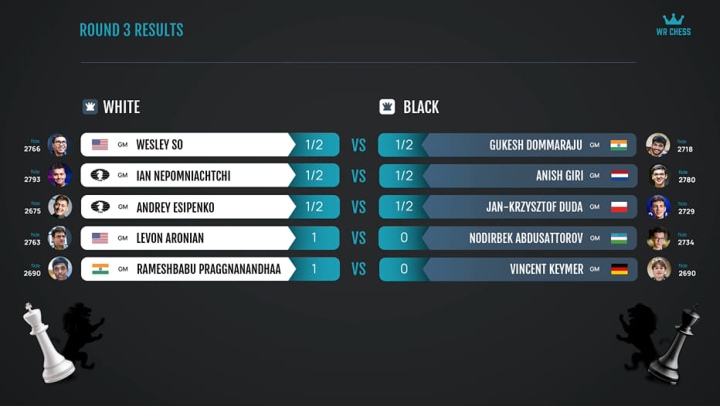
With a strategic masterpiece, Levon Aronian has taken the lead in the WR Chess Masters. Aronian gave Nodirbek Abdusattorov’s Sicilian Dragon no opportunity to breathe fire. Already at the end of the opening, the US-Armenian with the white pieces had transferred the game into an endgame without prospects for Black. With 2.5 /3, tournament senior Levon Aronian (40) tops the table. | Photo: Lennart Ootes In the live stream, Levon Aronian revealed the secret of his joy in playing: he is currently watching a “depressing” TV series from 1979, “Berlin Alexanderplatz”. The plot in 1920s Berlin is so sad, he said, “that it makes me happy as soon as I can sit at the board again. Everything is quite wonderful then.” And that obviously had an effect on his games, he said. A scandal and ahead of its time when it was released in 1980, Berlin Alexanderplatz by Rainer Werner Fassbinder, based on the novel of the same name by Alfred Döblin has since become a recognized masterpiece. With 2.5 points from 3 games, the US grandmaster is now alone in front. The other end of the standings is graced by the only player who was able to take half a point from Aronian so far. Vincent Keymer has only that half-point to his name after his third-round loss to Praggnanandhaa. “Pragg,” on the other hand, stopped the streak of two losses with a full point – and what a point it was. After Keymer missed a good opportunity to obtain counterplay with a central break and fully equalize the game after in the Ruy Lopez, he gradually got caught up in a king attack that soon became unstoppable. “To be on the scoreboard with a point is a good thing, of course,” the Indian rejoiced. What should I do: Vincent Keymer and Praggnanandhaa debriefing their game. | Photo: Lennart Ootes The other duel of players with 1.5 points from two games besides Aronian-Abdusattorov, Wesley So vs Gukesh, found no winner. Against Gukesh’s assumed Queen’s Gambit, the super-technician So seemed to get a position to his liking – a bit more space, a bit more activity – but it turned out that nothing tangible was up for grabs. After just 33 moves, a symmetrical endgame with 3 vs 3 pawns on the kingside was on the board, and the opponents agreed on a draw. So and Gukesh now share second place in the ranking with 2 points from 3 games each. Black is okay: Gukesh left nothing to chance against Wesley So. | Foto: Lennart Ootes The nominal tournament favourite, Ian Nepomniachtchi, doesn’t quite get going, at least in the first third of the tournament. In an English game against Wijk winner Anish Giri – number two against number five in the world – the upcoming World Championship finalist with the white pieces even had to be careful not to fall into a substantial disadvantage. Here, too, the matter was resolved around move 30 into a rook ending with nothing to gain for either side. Three games, three draws: Anish Giri, solid. | Photo: Lennart Ootes Jan-Krzysztof Duda was confronted with a Catalan opening for the second time in the tournament with Black against Andrey Esipenko. He avoided the mishap of the first round when he fell into a familiar trap against Wesley So. Nevertheless, things looked critical for a while. While Duda’s queen on the sidelines was doing no discernible work, a storm seemed to be brewing over his kingside. But all the worries of the Polish observers about their number one were unfounded. Esipenko managed no more than an endgame with a token advantage at best. After 44 moves, the opponents made peace. Interviews and analysis after round 3: Anish Giri – Interview after Round 3 of WR Chess Masters 2023 Wesley So – Interview after Round 3 of WR Chess Masters 2023 Levon Aronian analyses his game against Nodirbek Abdusattorov Rameshbabu Praggnanandhaa analyses his game vs Vincent Keymer Standings after Round 3: 1. Levon Aronian – 2½; 2-3. Wesley So and Gukesh D – 2; 4-7. Anish Giri, Ian Nepomniachtchi, Andrey Esipenko and Nodirbek Abdusattorov – 1½; 8-9. Jan-Krzysztof Duda and Rameshbabu Praggnanandhaa – 1; 10. Vincent Keymer – ½. Text: Official website Photo: Lennart Ootes Offical website: wr-chess.com/
The first Bahrain Chess Championship runs big
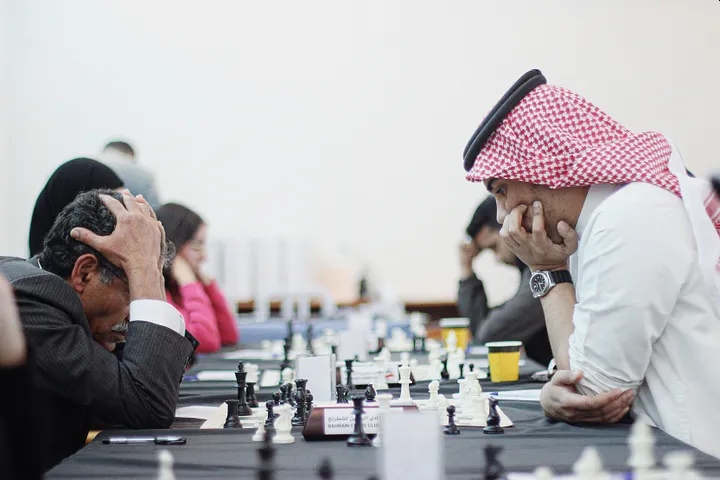
The first Bahrain Chess Championship took place in 2023 and was a great success. The event brought together Bahraini chess players from all over the country, and offered a great opportunity for the community to come together and enjoy the game. The future of the Bahrain Chess Championship looks bright, and the local chess community is looking forward to next year’s edition. With the support of HH Shaikh Khalid bin Hamad Al Khalifa, the Bahraini Chess Federation will continue to grow and bring out the best from Bahrain’s vast pool of talent. The team of organizers is committed to creating a vibrant and friendly atmosphere for all participants so that everyone can enjoy the game of chess. HH Shaikh Khalid bin Hamad Al Khalifa at Bahrain Chess School Tournament in 2022 The first Bahrain Chess Championship made a milestone in the history of chess in Bahrain. It has been made possible due to the edict issued in Jan 2023 by His Highness Shaikh Khalid bin Hamad Al Khalifa, which led to the formation of the Bahraini Chess Federation. The opening of the first Bahrain Chess Championship in 2023 was a remarkable celebration for the entire nation. Over 120 players from various governorates gathered to participate in this massive event that stretched over three weeks. The atmosphere of camaraderie permeated the whole tournament, and the enthusiasm for the game was clear to see as people eagerly discussed their moves and strategies. What began as just another regional event ended up becoming a high-energy gathering whose wholesome appeal quickly spread through word-of-mouth, drawing in more chess fans than initially believed possible. The national men’s team of Bahrain for the year 2023, which was formed after the tournament, consists of the champion Husein Ayyad (pictured below), Maher Ayad, Khalaf Boukhlef, Ibrahim Burshid and Ali Al-Ghasra. Bahrain Women’s Champion (2023) Hawra Sharaf Final standings: 1 FM Ayyad, Husain 2220 8½ 2 FM Ayyad, Maher 2090 8 3 Bukhalaf, Khalaf 1836 7 4 Al-Burshaid, Ebrahim 1704 7 5 CM Al-Ghasra, Ali 2048 7 6 Shaker, Musab 1709 7 7 Taqi, Mohamed 7 8 Monther, Alfardan 6½ 9 Sharaf, Hawra 1272 6½ 10 Obaid, Abdulrahman 1280 6½ You can find complete results here: https://chess-results.com/tnr721779.aspx?lan=1&art=4&turdet=YES&flag=30 The national women’s team of Bahrain for the year 2023 was also formed following the tournament and consists of Hawra Sharaf, Maram Al-Mousawi, Wafaa Ibrahim, Naglaa Ahmed and Sondos Obaid. Bahrain Women Champion (2023) Hawra Sharaf Based on the tournament results, various boys teams, Under 20, Under 18, Under 16, Under 14, Under 12 and Under 10 were formed. The top players in each category are Mohamed Taqi (Under 20), Abdul Rahman Obaid (Under 18), Ronen Abdullah (Under 16), Sayed Hashim Ali (Under 14), Mahmoud Al-Mousawi (Under 12) and Jad Tariq Jawad (Under 10). Similarly, for the girls, the players chosen for each category are Honorable Mention Hawara Sharaf (Under 20), Maram Al Mousawi (Under 18), Sondos Obaid (Under 16), Dania Obaid (Under 14), Reem Al Salman (Under 12) and Joud Al-Faraj (Under 10). All these players are highly talented and have the potential to bring glory to Bahrain in international tournaments. The event was officiated by a team of arbiters as follows: Chief ArbiterFA/FT/CM/SI Larbi Ben Yahya, Deputy Chief ArbiterNA Mohsin, Basim A. Arbiter : IM/FT/NA/ Mohamed Tissir| NA Mostafa Salah| NA Amal Jawad Alhashemi| NA Ahmed Ebrahim Hasan The event’s arbiters The first Bahrain Chess Championship was a resounding success, with many participants and spectators. This popularity is only set to increase in Bahrain and the broader region as chess continues to gain traction. With its rich history and strong foundations, Bahrain is poised to become a leading force in the world of chess. We hope to see you at the next edition of the Bahrain Chess Championship! Text: Ebrahim Al-Burshaid Photo: medium.com
WR Chess Masters: Gukesh and Abdusattorov join the leaders
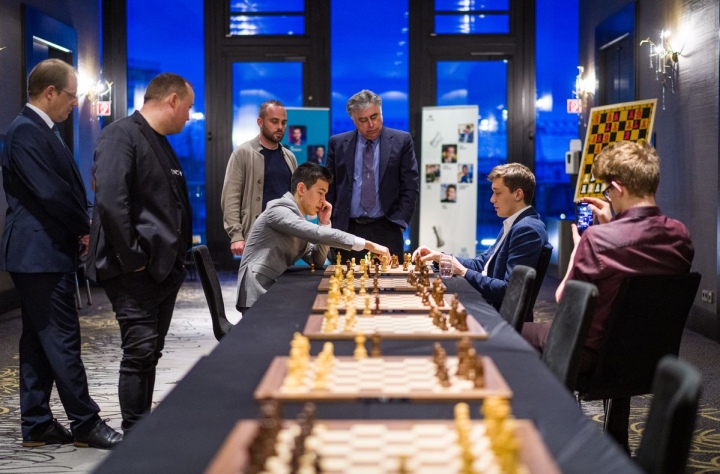
Gukesh and Nodirbek Abdusattorov have joined the leaders with wins in the second round of the WR Chess Masters. Together with Wesley So and Levon Aronian, the two youngsters make up the quartet at the top of the table with 1.5 points from 2 games. A “fantastic game”, according to Yasser Seirawan, who was happy to watch Nodirbek Abdusattorov and Andrey Esipenko analyze the complications afterwards. Gukesh fought a fierce, wide-open battle in the Indian duel against Praggnanandhaa, who made a mistake under time pressure. Gukesh conjured up a remarkable mating final, which his compatriot did not want to see until the end. Praggnanandhaa is now alone at the bottom of the table with 0/2 – a snapshot. A fierce, wide-open battle between the two Indians Gukesh and Praggnanandhaa. | Photo: Lennart Ootes Nodirbek Abdusattorov showed nothing less than “a fantastic game” (Yasser Seirawan) against Andrey Esipenko, who had had to struggle for more than seven hours for his full point against Vincent Keymer the day before. On Friday, he was caught after just over an hour by a double-piece sacrifice from Abdusattorov, who got an almost irresistible attack in return. Three games ended in draws, including the rather uneventful encounter between Anish Giri and Wesley So, who gave the Dutchman the bishop pair in an almost symmetrical endgame – and proved that it meant no added value in that constellation. Jan-Krzysztof Duda seemed to have carved out some initiative against Ian Nepomniachtchi’s Russian Defense, but Black found enough counterplay to let matters fall flat. It was a similar story between Vincent Keymer and Levon Aronian. What initially looked like a threatening king attack was not nearly enough to shake the black bastion. Nodirbek Abdusattorov – Andrey Esipenko 1:0 After the game, Nodirbek Abdusattorov solved a mystery of the previous day, interviewed by Elisabeth Pähtz: Hadn’t he been virtually at a loss in his Benko Gambit after seven moves against Ian Nepomniachtchi? “Yes, I was,” the Uzbek admitted. He had confused a move sequence from his preparation, which led to 7…Be7? That could have been a fatal mistake. Esipenko’s luck: “Ian trusted that I knew what I was doing.” Had Andrey Esipenko not played for more than seven hours the day before, perhaps he would have found time to exchange ideas with his opponent Vincent Keymer about the cutting-edge Nimzo-Indian Variation that was on the board between Abdusattorov and Esipenko on Friday. Keymer associates it with intense memories of his debut in the German national team in November 2021, when he peppered a knight into the castling position of his opponent Jonas Buhl Bjerre – only to find out that the Dane was prepared for it. It was precisely this sacrifice and some related subtleties that Abdusattorov showed in the live stream after the game, a visual example of what’s in store against the two under-defended black Achilles heels, f7 and h7. The impact 15.Bxh7! on one of these weak points, followed by the conquest of the second by means of 16. Qh5+ should be particularly favourable. 14…Nxd2 had been a mistake, Abdusattorov explained, but an understandable one: It was already difficult to find a good move, and the exact consequences of the double piece sacrifice (White doesn’t intend to capture the knight on d2) were hard to calculate. In the course of the skirmish, which was hard for mere mortals to follow, Esipenko was offered one chance to save himself: 21…Qe8 would have kept black’s chances of survival intact. Esipenko instead played the natural-looking 21…Qg5, which leads to a loss – if White sees how to continue. On Twitter, grandmaster, author and chess coach Jacob Aagaard demonstrated how difficult this is by giving two best moves and asking which is now the correct 24th move. Position after 23…cxd4. White moves and wins – how? What Aagaard demonstrated as the best sequence, the two highly talented players on the board calculated and played in exactly the demonstrated way. Now on move 24 the key is that it’s not the tempting 24.Rh3 clinches the game, but only 24.Qf7! Abdusattorov played that too, and Esipenko soon ran out of ideas about how he could still pose problems. With this win, Abdusattorov, who has only just broken into the world’s top 20, moves into the vicinity of the top 10. He is now ranked 14th in the live list. Vincent Keymer – Levon Aronian ½-½ The extent to which players from the 2700 class are prepared was hinted at by Vincent Keymer after his game against Levon Aronian. Already on move five he had left well-trodden paths with the quasi-novelty 5.Bxc6 followed by 6.f4. “You have to try something in every game, after all.” But Keymer noted, even in this new position, “Levon knew one of the equalizing paths.” Structurally it looked good for White in the course of the game, “potential was there,” but Keymer failed to turn that potential into something tangible against Aronian’s precise play. The 18-year-old is nevertheless flirting with scoring a full point as soon as possible after his loss in the opening game. However, that requires a balancing act with veritable opponents like those in Düsseldorf: challenging fate in an exaggerated manner could “very easily lead to further defeats”. Jan-Krzysztof Duda – Ian Nepomniachtchi ½-½ With six weeks to go, Ian Nepomniachtchi will play a world championship match. On Friday in Düsseldorf, memories of his World Championship match at the end of 2021 against Magnus Carlsen may have come back to him. For 13 moves, Duda and Nepo followed the 4th match game, and then the Pole deviated. Meanwhile, Yasser Seirawan celebrated in the live stream his explanation of what it’s all about for White: pressure against d5. That’s why White should eliminate the white-squared bishops (which Duda did immediately with 17.Rxe7 and 18.Ba3), in order to be able to plant a rook on e5 in the medium term. The Nh4, meanwhile, would have the task of jumping to e3 or f4 via g2 in order to target d5 from there. The
Ofer Comay wins 19th International Solving Contest
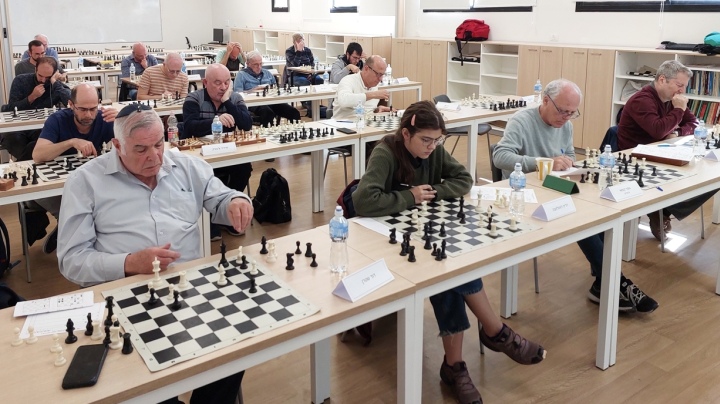
Photo above: Israel Chess Composition Society The International Solving Contest (ISC), traditionally held on the last Sunday of January, has marked the beginning of solving seasons for almost two decades. It’s a hybrid competition, with the same groups of chess problems and endgames distributed around the world to be solved at the same time. This year, it attracted 601 solvers from 28 countries in 38 different locations. Each location had a local controller responsible for the integrity of competition and communication with the Central controller Axel Steinbrink. Solvers in Chennai, Rio de Janeiro, Ulaanbaatar and Tokyo | Photo: Mount Chess Academy, Lucas Roland, Tongon Sumiya and Tadashi Wakashima The problems, adjusted to three different levels of skills, were carefully prepared by a group of most devoted FIDE Solving Judges: Axel Steinbrink (Germany), Ivan Denkovski (North Macedonia) and Luc Palmans (Belgium). Miodrag Mladenović (Serbia) helped to enter results in the Solving Tournament Manager program (STM), and Borislav Gadjanski (Serbia) took care of the daily live transmission of results on the Mat Plus website. Axel Steinbrink did the most delicate part of the work, checking over a thousand scanned solving sheets. He was on duty for the 14th time! FIDE Solving Judges Ivan Denkovski and Axel Steinbrink | Photo Fujairah Chess & Culture Club They were the real heroes of the ISC 2023, each of them volunteering for the solvers’ entertainment, the way most of the projects by the World Federation for Chess Composition (WFCC) are done. The ISC is a friendly and easy-to-join competition aimed at popularizing chess art in the first place. After the careful supervision of the solving sheets, the ISC 2023 Winners were announced. The 1st and the strongest Category had 12 problems split into two rounds of 120 minutes each. Together, there were two problems from each of the six different genres: mate in 2, mate in 3, mate in more moves, endgame, helpmate and selfmate. (This year, because of the sanctions, there were no competitions of the 1st and 2nd Categories in Russia and Belarus). In spite of the relatively long average time of 20 minutes per problem, it’s usually extremely difficult to get the perfect 60 points result (5 points per problem) in Category 1, and the 2023 edition was no exception. The main hitch was the following endgame: White to play and draw What looks like an elementary ending hides, in fact, a long sequence of the only moves on both sides before all resources get exhausted. The most successful solvers ended their search before the 9th move and got 3 points out of 5. There were five more moves to find, and only the Indian Grandmaster Karthikeyan Murali got 4 points. The ISC winner, Ofer Comay of Israel (second from the right on the first photo), also netted 3/5 in this endgame, but overall he scored 58 points and spent a shorter time (215 minutes) than Eddy van Beers from Belgium (2nd place) and Kacper Piorun of Poland (third place). The win of a senior solver (65+) may sound like a huge surprise, but the skills of the triple World champion in solving should never be underestimated. Ofer won WCSC in his first appearance back in 1980 and did it again in 1985 and 1996. Solvers in Lativa | Photo: Latvijas Problēmšaha Biedrība The best lady was Woman Grandmaster Laura Rogule (pictured above), 12 times chess champion of Latvia, and Ilija Serafimović (18) from Serbia was the most successful among the youngest participants (U23). The ISC Category 2 was for the participants with solvers rating up to 2000. It had the same format and genres as Category 1, but the problems were less difficult. The top result by the 15-year-old Daniel Dumitrescu and the 3rd place-finish by Radu-Cristian Fluerariu (20) confirmed the rise of the Romanian solvers, while the 2nd place was another success of the Latvian talent Emils Tabors (16). Among the obstacles to overcome, the next mate-in-five raises a tricky question: how to activate Rook and King – to the left or to the right side? The answer turned out to be – to both sides. White to play and mate in five moves The ISC Category 3 was a youth U13 competition (for those born in 2010 and later). It lasted 120 minutes and included 6 problems: 4 of them in 2 moves, 1 in 3 moves, and 1 endgame. This time youngsters had no trouble reaching the maximum of 30 points. No less than six of them did it, and the three winners were extremely fast. Grigory Filin spent only 22 minutes, Taras Rudenko – 26, and Viktoriya Merkulova – 28 minutes! To get the feeling of the traps the kids had to avoid, you may try to crack the following three-mover. Out of several seemingly equal choices, only one leads to the goal! White to play and mate in three moves The season of international solving competitions continues with the open championships of Finland (February 18), the Netherlands (March 4), and Poland (March 4-5). All of them are legs of the World Solving Cup, organized by the World Federation for Chess Composition. The solutions to the problems from ISC 2023 (with points in brackets) 1. (Martin Minski, Original for Seven Chess Notes 2023) 1. f4! Kxf4 2.Nf2 [1] 2. … K 3 3.Ng4+ Ke2 4.Ne5 [1] 4. … Bd7+! 5.Kc7! Bg4! 6.Bf1+! [1] 6. … Kf2! 7.Nd3+! Ke3! 8.Nb2 Kd4 9.Bb5! [1] 9. … Kc3 10.Bd7 Be2 11.Na4+ Kb4 12.Nb2 Kb3 13.Nd3! [1] (13. … d1Q 14.Ba4+! Kxa4 15.Nb2+) 2. (Isai Hillel Rozenfels, Shakhmaty v SSSR 1954) 1.a4! b5 2.Kg1 bxa4 3.Rf1 a3 4.Be1 & 5.Bc3# [2.5] 1…b6 2.Rd1 b5 3.Ke1 bxa4 4.Kd2 a3 5.Bc3# [2.5] 3. (Vladimir Bron, 1. Pr. Ukraine T. 1952) 1.Rd7! e5 2.Qa2+ & 3.Qa8# 1…Kf8 2.Qc5+ & 3.Qc8# 1…e3 2.Qxf3 & 3.Qa8# 1…Kh8 2.Qh4+ Kg8 3.Qd8# Text: Marjan Kovačević, WFCC President Official website: https://www.wfcc.ch/

